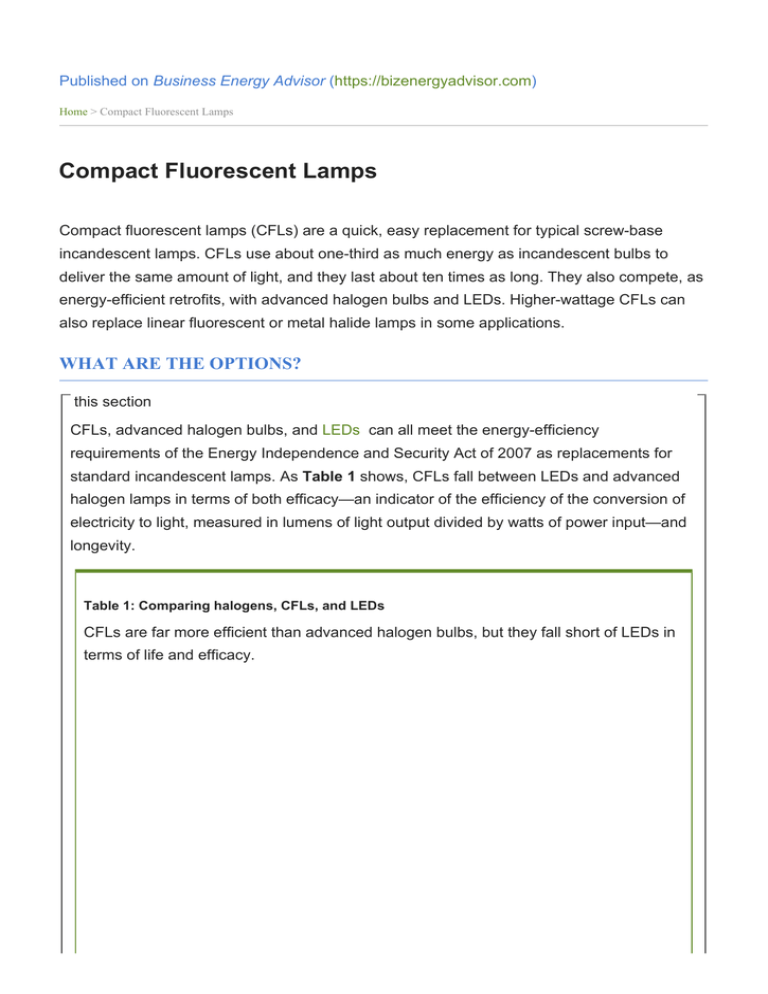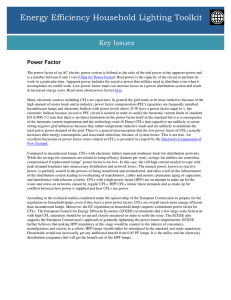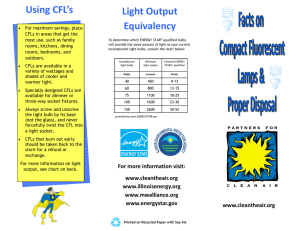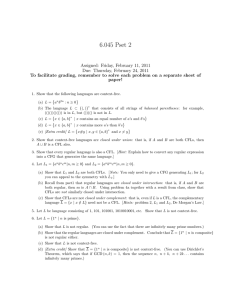
Published on Business Energy Advisor (https://bizenergyadvisor.com)
Home > Compact Fluorescent Lamps
Compact Fluorescent Lamps
Compact fluorescent lamps (CFLs) are a quick, easy replacement for typical screw-base
incandescent lamps. CFLs use about one-third as much energy as incandescent bulbs to
deliver the same amount of light, and they last about ten times as long. They also compete, as
energy-efficient retrofits, with advanced halogen bulbs and LEDs. Higher-wattage CFLs can
also replace linear fluorescent or metal halide lamps in some applications.
WHAT ARE THE OPTIONS?
this section
CFLs, advanced halogen bulbs, and LEDs can all meet the energy-efficiency
requirements of the Energy Independence and Security Act of 2007 as replacements for
standard incandescent lamps. As Table 1 shows, CFLs fall between LEDs and advanced
halogen lamps in terms of both efficacy—an indicator of the efficiency of the conversion of
electricity to light, measured in lumens of light output divided by watts of power input—and
longevity.
Table 1: Comparing halogens, CFLs, and LEDs
CFLs are far more efficient than advanced halogen bulbs, but they fall short of LEDs in
terms of life and efficacy.
Another alternative is the cold-cathode fluorescent lamp (CCFL). CCFLs use thicker
electrodes and higher voltages than standard CFLs. CCFLs dim much more readily than
CFLs and provide longer life (25,000 hours or more). But these lamps cost more than
CFLs, are slightly less efficient, and are currently only available in lower wattages (from 2
to 18 watts).
CFL shapes and configurations. The most common CFL today is the spiral lamp, but CFLs
come in a variety of shapes (Figure 1), each of which provides different light density and
distribution and a better fit in certain fixtures. CFL products also come both with and
without reflectors. Nonreflectorized lamps are usually used in table lamps, floor lamps, and
other fixtures designed to put out diffuse light. Reflectorized lamps provide more-focused
light. CFLs may also be covered in various ways to mimic standard incandescent lamp
shapes, such as A-lamps and parabolic aluminized reflector (PAR) lamps. For a guide to
which types of lamps work best in different types of applications, visit the Choose a Light
Guide created by Energy Star (a voluntary US Environmental Protection Agency program
that helps businesses and individuals reduce their use of energy).
Figure 1: CFLs come in many shapes to fit different applications
Although bare spiral lamps are the most common CFL configuration, a wide range of
shapes and sizes are available to provide different light densities and distributions and
to fit better in certain fixtures. Lamps may also be covered in a variety of ways to mimic
different types of incandescent lamps.
Ballasts. Ballasts, which control lamp current and provide the required start-up voltage,
may be either magnetic or electronic. Most early CFLs used magnetic ballasts, which
operate at line frequency—60 hertz. Today, most CFLs use electronic ballasts, which are
lighter, quieter, and more efficient. Electronic ballasts may cause electromagnetic
interference with some types of sensitive equipment that may be operating nearby. Typical
operating frequencies are 20 to 60 kilohertz. Dimming ballasts are also available, but
they’re costly.
Starting method. CFL ballasts may use one of three different starting methods: preheat,
rapid start, or instant start. Preheat ballasts heat the lamp electrodes for several seconds
before a starter switch allows a voltage of 200 to 300 volts to be applied across the lamp.
CFLs with magnetic ballasts may flash on start-up with preheat, but electronic units will not.
Rapid-start units use a low voltage to heat the electrodes quickly and then apply a starting
voltage of 200 to 300 volts. The heating voltage is applied even after the lamp starts,
leading to small decreases in efficiency. No flashing occurs with rapid-start units. The
latest variation is the programmed-start ballast (also called the programmed rapid-start
ballast), which more precisely controls the starting process to enable longer lamp life.
Instant-start ballasts allow the CFL to start without delay by supplying a high initial voltage
(more than 400 volts). Efficiency is highest with this type of ballast, but lamp life is reduced
because the high voltage speeds up the degradation of the emissive coating on the
electrodes. In applications with frequent on/off switching, such as those that use
occupancy sensors, instant-start ballasts will shorten lamp life relative to other ballast
types.
Self-ballasted and pin-base configurations. CFLs may be self-ballasted or pin-base, and pin-
base units may be either modular or dedicated (Figure 2). Also known as screw-base,
screw-in, or integrally ballasted CFLs, self-ballasted CFLs are designed to replace
incandescent lamps without requiring any modifications to the existing incandescent lamp
fixtures. Self-ballasted CFLs combine a lamp, ballast, and base (the Edison screw
base—or, in some countries, another standard base that fits the incandescent lamp
socket) in a single, sealed assembly. Self-ballasted CFLs are most often constructed with
T4 (four-eighths inches in diameter) or smaller tubing, but a few designs use T5 tubing.
The entire assembly is discarded when the lamp or ballast burns out.
Figure 2: CFL lamp-and-ballast configurations
CFLs come in three different configurations: self-ballasted, modular, and dedicated.
Both modular and dedicated lamps are pin-base configurations.
Pin-base CFLs are designed to be used with a separate ballast—users need to make sure
that lamp and ballast are compatible. Pin-base CFLs are available in lower-power versions
to replace incandescent lamps and in higher-power versions to replace linear fluorescent
lamps or even high-intensity discharge (HID) lamps.
Modular units plug a separate lamp into an adapter—Edison-style or otherwise—so that
when the lamp burns out, the entire assembly need not be discarded. Instead, a relatively
low-cost replacement lamp can be installed in the same ballast base, which typically lasts
for 40,000 to 60,000 hours of operation. Lamps for modular units have either two or four
pins in their bases—two-pin lamps work with magnetic ballasts, and four-pin units work
with electronic ballasts. The key disadvantage of modular units is that the pin base on the
lamp and the matching socket on the adapter make modular CFLs larger than selfballasted CFLs of equivalent light output. The development of low-cost electronic ballasts
for self-ballasted CFLs has decreased the cost advantage and popularity of modular
systems.
Dedicated systems, also called hardwired systems, feature a ballast and fluorescent lamp
socket that are permanently wired into a fixture by the fixture manufacturer or as part of a
retrofit kit. As with modular systems, the lamp can be replaced with another compatible pinbase CFL when it burns out. Because dedicated systems are hardwired and not screwed
into a standard screwbase socket, they eliminate the possibility that a user will switch back
to an inefficient incandescent bulb when the CFL burns out.
An alternate base for self-ballasted lamps, the GU-24 base—see slide 9 in this Energy Star
Electrical Distributors Training presentation (PPT) for an overview of this technology—is
designed to replace the Edison socket and base in energy-efficient lighting fixtures while
also preventing users from installing incandescent lamps. The GU-24 design gives users
more flexibility than a pin-base design (which has a separate ballast that only accepts a
bulb with a specific wattage).
Wattage. CFLs come in a wide range of power ratings, from 2 to 200 watts for screw-in
versions and up to 120 watts for hardwired models. Manufacturers often claim that their
lamps produce light output equal to that of incandescent bulbs of a certain wattage, but
these ratings should be viewed with caution, given that there aren’t any formal standards
for such claims. One manufacturer’s 18-watt product might be labeled as equivalent to a
60-watt incandescent, while a similar product from another vendor might be labeled as a
75-watt equivalent. As a rough guide, a 3:1 ratio of incandescent to CFL wattage yields
equivalent light output.
HOW TO MAKE THE BEST CHOICE
this section
First, choose a lamp that meets your requirements for shape, light output, and
configuration. Compare the life-cycle costs of CFLs to other energy-efficient options. Table
2 presents one example, but numbers will vary depending on the type of bulb under
consideration, the hours of use, and the local prices and energy costs. If you’ve decided to
go with CFLs, review the following recommendations.
Table 2: Life-cycle costs for energy-efficient alternatives
LED lamps offer a wide range of performance and cost, with the best LEDs providing
life-cycle savings over most of the alternatives. Non-dimmable CFLs provide the lowest
life-cycle cost, but without the dimming benefit. The calculations below use values for
specific products that provide roughly equivalent amounts of light. Life-cycle costs are
based on a 25,000-hour life, which is typical for A-lamp-type LEDs.
Choose a CFL that is suitable for the expected conditions. Lamps for use in cold weather
should have ballasts that are rated for cold-start conditions. Exposure to high
temperatures, such as those found in reflectorized-can fixtures, can shorten the life of a
CFL ballast. More information on CFL reflector lamps can be found in the Pacific
Northwest National Laboratory’s publication A Review of the Reflector Compact
Fluorescent Lamps Technology Procurement Program: Conclusions and Results (PDF). If
you’re going to be installing CFLs in areas where they’ll experience temperature extremes
(such as poorly vented enclosed fixtures where heat can build up or in outdoor applications
in cold climates), look for products that specifically state that the CFL will provide stable
light output over a broad range of temperatures and in various positions. Most CFLs
available today (the exceptions are circline and high-power twin-tube models), use what is
known as amalgam technology, which makes them less sensitive than older models to
variations in position and temperature. But the use of amalgam can make a lamp take
longer to heat up and reach full output. In very cold conditions, LEDs may be a better bet,
although performance of both CFLs and LEDs can degrade in very hot conditions.
Choose a lamp with the appropriate color quality. The correlated color temperature (CCT) of
a CFL is a measure of the warmth of its appearance. Lower CCT numbers mean the light
will be a warmer white (yellowish), and higher numbers mean it will provide a cooler light
(bluish). Most self-ballasted CFLs are available at 2,700 to 3,000 kelvin (K), which is the
color temperature of most of the incandescent lamps they’re designed to replace. This
color range works well in most residential settings and enhances warmer colors found in
the home. Pin-base CFLs are generally available in four color temperatures: 2,700 K;
3,000 K; 3,500 K; and 4,100 K. Models with color temperatures of 5,000 and 6,500 K are
available in certain sizes. Some self-ballasted lamps are available in these higher color
temperatures as well. These colors are usually described as ?bright white,? ?natural,? or
?daylight.?
Note that light from products with the same CCT that are made by different manufacturers
may look different. Therefore, using lamps from a single manufacturer in a large installation
will help to ensure that all of the CFLs will produce the same color effect.
Lighting manufacturers also use another color metric, color rendering index (CRI), to
quantify the color quality of a light source at a given color temperature. The more
accurately a source renders a sample of eight standard colors relative to a reference
source, the higher the CRI (measured on a scale of 0 to 100). Incandescent bulbs typically
boast CRIs close to 100, whereas most CFLs have CRIs ranging from 82 to 86. A CRI of
80 or more is generally considered acceptable for indoor lighting, but some lighting
professionals call for a CRI of at least 90.
Consider power quality. Using CFLs in a home will not affect power quality appreciably, but
using significant quantities of them in a large facility can have an impact. In those cases,
look for products with low (below 30 percent) total harmonic distortion and power factors
greater than 0.9. High power factors are the norm for pin-base CFLs with electronic
ballasts, but it can be harder to find them in self-ballasted CFL products. When CFL
manufacturers state that their product has a high power factor, it means that its power
factor is greater than 0.9. The power factor of a CFL will not significantly affect its energysaving benefits for the individual consumer, but the use of CFLs in large numbers—such
as in commercial applications or across millions of homes in a distribution system—could
require infrastructure upgrades.
Choose dimmable CFLs for dimming circuits. CFLs should not be installed in sockets
controlled by incandescent lamp dimmers unless they are specifically labeled as dimmable
products. Dimmable self-ballasted CFLs are available, but they cost two to three times
more than nondimmable CFLs, and they don’t generally dim as smoothly or as deeply as
incandescent lamps. Nor do they shift to a warmer color as they dim—a property that users
have come to expect from dimmed incandescent bulbs—and something that some LED
products can do. In addition, dimmable CFLs do not work equally well on all existing
dimming circuits and may require the replacement of the dimmer. Some pin-base CFLs
can be dimmed effectively using electronic ballasts similar to those used to dim linear
fluorescent lamps, but again, these ballasts are pricey.
Limit the number of CFL types. CFLs are available in a wide variety of sizes and shapes. In
commercial applications, it’s useful to standardize with just a few types to reduce stocking
requirements and confusion at relamping time.
Select a lamp that meets Energy Star requirements. The Energy Star program, the EPA and
the US Department of Energy have developed a set of specifications for cost-effective,
energy-efficient CFLs. Manufacturers test their products against these guidelines, and the
Energy Star website spells out the requirements and lists all qualifying products. To find
product specifications, lamp options, and more, go to the EPA’s Light Bulbs page.
Use an Energy Star–approved fixture. If you’re going to purchase a new fixture, not just a
new bulb, choose an Energy Star–approved fixture that doesn’t accept incandescent bulbs
but takes only pin-base or GU-24-base CFLs. That choice will ensure that the energy
savings last and that the light distribution is appropriate for the CFL. See the EPA’s
Residential Light Fixtures page for more information.
WHAT’S ON THE HORIZON?
this section
CFL product offerings have improved a great deal in color quality, reliability, and
dimmability since their introduction, but most lighting research today focuses on LED
lighting. So, although CFLs still have a role to play, we expect that to diminish over time as
LEDs continue to come down in price and improve in performance.
WHO ARE THE MANUFACTURERS?
this section
A number of companies produce CFLs, including:
GE Lighting
Litetronics International Inc.
MaxLite
Osram Sylvania
Philips
Technical Consumer Products Inc.
Westinghouse Lighting
In addition, you can visit the Energy Star Certified Light Bulbs page for a list of qualified
LED and CFL products.
Neither this list nor any mention of a specific vendor or product constitutes an endorsement
or recommendation by ESource, nor does any content in the Business Energy Advisor
constitute an endorsement or recommendation, explicit or otherwise, of your service
provider’s various technology-related programs.
All content copyright © 1986-2016 E Source Companies LLC. All rights reserved.
Source URL: https://bizenergyadvisor.com/BEA1/PA/PA_Lighting/PA-02




